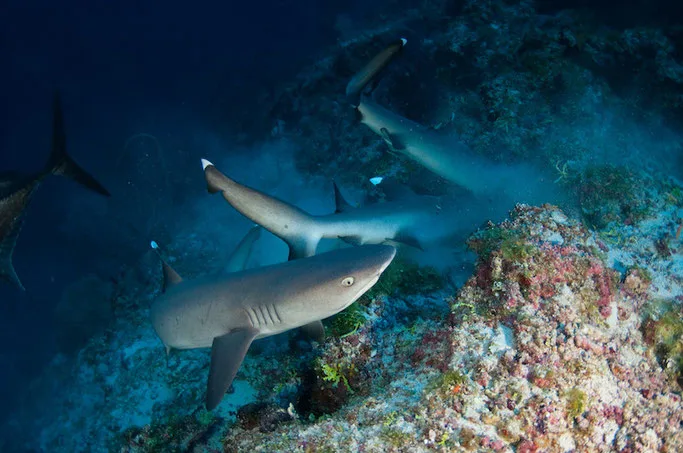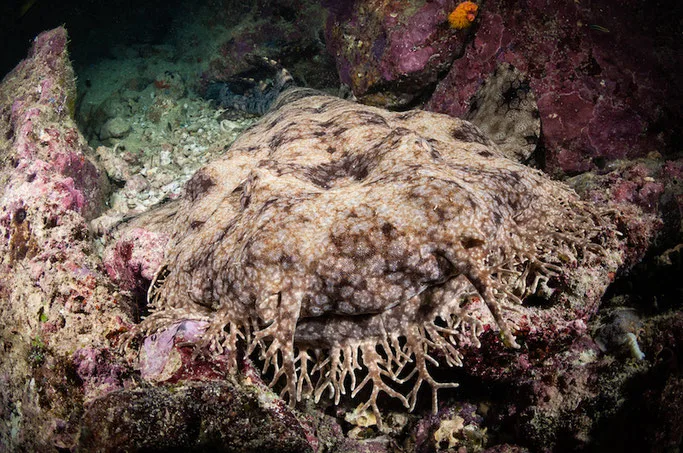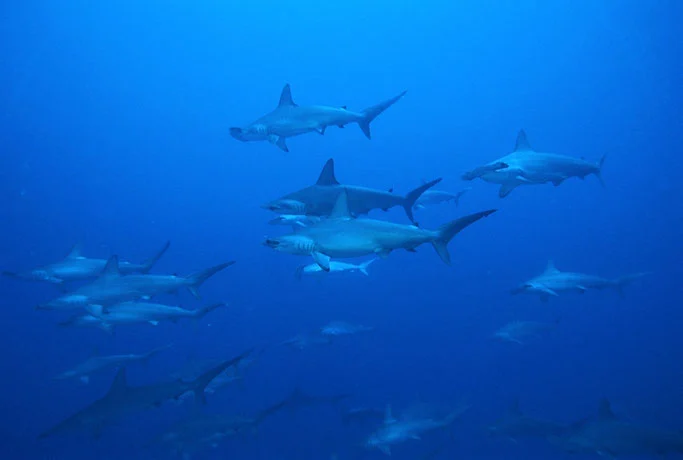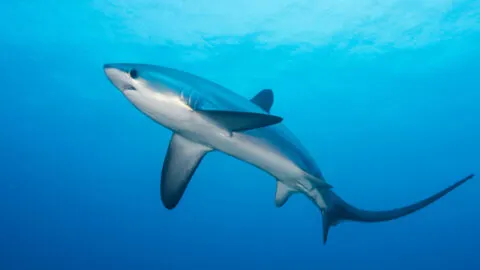Few divers can forget their first exhilarating encounter with a shark and for many, diving with sharks is the ultimate, awe-inspiring experience. From encounters with schooling hammerheads and hunting reef sharks, to searching for unique species and snorkeling with the giants of the oceans, read on and discover ZuBlu’s selection of Asia’s best shark diving experiences.
1. MALAPASCUA, PHILIPPINES
The reefs and shoals that surround Malapascua are home to some amazing species – particularly the legendary Monad Shoal, with its resident thresher sharks. The shoal is an underwater plateau with several cleaning stations along its reef edge. The thresher sharks come in from the deep water surrounding the shoal at dawn and can be seen using the services of cleaner wrasse and other species of fish that clean the sharks skin of debris and
parasites. Aside from the unique opportunity to see these stunning and elusive sharks, Malapascua has a lot more to offer for divers. The island itself is surrounded by some fantastic muck-diving and nearby Gato Island has some incredible reef structures as well as a tunnel running under the island that is home to whitetip sharks. Combined with some exceptional resorts and beautiful beaches, Malapascua is best described as an epic shark diving destination!
Great for: Thresher sharks!
Best time to visit: March to May, then the weather is good and before the crowds appear over the summer months.
2. FUVAHMULAH ATOLL, MALDIVES
Situated in the far south of the Maldives, Fuvahmulah lies closer to the equator than any other Maldivian island or atoll. Nicknamed the Maldivian Galapagos, this isolated atoll promises pristine reefs, large pelagics such as oceanic reef manta rays and mola mola, as well as fantastic encounters with thresher and tiger sharks. With over 20 known dive sites to explore and more being discovered every year, Fuvahmulah’s relatively unknown dive scene, unique location and isolation make it one of the best destinations for exploratory divers in the Maldives.
Depending on the currents and monsoon season, visitors have a very good chance to encounter large species such as the oceanic black manta ray, Mola mola and pilot whales, along with huge schools of barracudas, yellowfin tuna, bonitos and sailfish. However it is the resident tiger sharks that have made Fuvahmulah famous in recent years. These big sharks have played an important role in the local habitat for decades, feeding on the entrails and other fishy remains discarded by fisherman. These magnificent sharks can be seen nearly every day and whilst the sharks are in no way aggressive, the experienced dive guides ensure all necessary safety precautions are taken. Another exciting possibility are sightings of thresher sharks, frequent visitors to several sites around Fuvahmulah.
Great for: Tiger sharks, thresher sharks, pelagic species.
Best time to visit: December to March. With the atoll’s proximity to the equator, the monsoon are less pronounced compared to further north in the Maldives and the weather is pretty stable all year round. The dry north-east monsoon usually runs from December to March with the wet south-west monsoon from May to November.
3. VAAVU ATOLL, MALDIVES
The reefs on the eastern side of the atoll facing the open ocean and positively packed with life, providing an opportunity for some truly exciting diving – even by Maldives’ standards, Vaavu’s channels are very special indeed. The strong tidal currents through Vaavu’s channels mean thrilling shark dives, with large numbers of grey reef and white tip reef sharks amidst swirling schools of barracuda, snapper and trevally.
The underwater topography of the outer reef and channels is dominated by large overhangs and a honeycomb of caves, as well as swim-throughs carpeted in soft corals, while the inside of the atoll has plenty of small, shallow reefs that are perfect for the inexperienced diver to enjoy schools of reef fish. The signature site is Fotteyo Kandu which could easily be considered one of the best dive sites in the Maldives. The narrow channel has swim-through’s, small caves and large overhangs to explore, as well as a drop-off covered in colourful soft corals. Out in the blue, hammerhead sharks are always possible, along with grey reef and white tip sharks, and large schools of trevally and sweetlips. Nearby Miyaru Kandu, which translates to ‘Shark Channel’ certainly lives up to its name and large schools of grey reef sharks, white tip reef sharks, plus tuna and Napoleon wrasse, are all commonly seen. Last, but not least, Kunaavashi Kandu or Second Channel is another incredible site that has beautiful soft corals, squadrons of spotted eagle rays and big marbled stingrays.
Great for: Reefs sharks, hammerhead sharks, pelagic species, schooling fish, manta rays and current-fuelled channel dives.
Best time to visit: January to April is probably the best time to visit, with great weather and strong tidal flows through the channels. At the start of the northwest monsoon from May to June, manta rays become more common.
Read more: Best Wreck dives in Maldives
4. RASDHOO ATOLL, MALDIVES
Rising out of the ocean depths, this small atoll has found fame as the best location in the Maldives for encounters with hammerhead sharks. The atoll is also the site of some spectacular dive experiences with other sharks species, manta rays and schooling fish, and visitors can explore its deep reef walls and dramatic underwater topography. Combined with beautiful beaches and the welcoming community on the local island, Rasdhoo easily ranks as one of the Maldive’s best shark diving destinations.
At Rasdhoo Madivaru, divers head out into the blue at dawn in search of the resident hammerheads that are regularly encountered. Back at the reef, reaching out across one of the southern channels, a horse-shoe shaped ridge is patrolled by grey reef sharks, whitetip sharks and schools of eagle rays whilst an expansive sandy bowl is home to whiptail rays, marble rays and patches of garden eels. Throw in the occasional spotted eagle ray and a school of large barracuda and divers have all the ingredients for a near-perfect Maldivian dive experience.
Great for: Reef sharks, hammerhead sharks, eagle rays, manta rays, big stingrays and schooling fish.
Best time to dive: January to April. The dry northeast monsoon usually brings blue skies and calm winds – perfect weather for a topical holiday – along with manta rays that can be seen at cleaning stations. However, Rasdhoo can be dived year round.

5. MARATUA, KAKABAN & SANGALAKI
Running parallel to the coastline of Kalimantan’s (the Indonesian portion of the island of Borneo) northern coast are a string of islands, reefs and atolls known as the Derawan Archipelago. Due to the effort required to get out to the islands, these islands have remained ‘under the radar’ for many divers. However, those willing to make the long journey to Derawan, Sangalaki, Kakaban or Maratua are rewarded with some incredible underwater experiences – with whale sharks, turtles, manta rays and huge schools of fish all on the cards.
The area has become known as one of the ’sharkiest’ in Indonesia, with regular sightings of reef sharks, leopard sharks, hammerhead sharks, thresher sharks and whale sharks. Add in the turtles, schools of barracuda, manta rays and beautiful reefs and walls, and you soon realise why divers are prepared to make the long trip out to the islands.
The best locations for shark encounters are around Kakaban, where the reefs drop away sharply and are swept by strong currents – perfect conditions for schooling fish and bigger animals including leopard sharks, grey reef sharks and the occasional hammerhead shark. Further east at the edge of the continental shelf, Maratua is home to the area’s best site – the mouth of the atoll’s single channel where the currents concentrate a huge amount of fish life, including sharks and a huge school of barracuda.
Great for: Reef sharks, leopard sharks and the occasional hammerhead and thresher shark. Whale sharks can also be seen closer to the mainland.
Best time to go: April to July. Between the end of the rainy season and the start of the summer winds, the weather is at its best and the diving fantastic. However, the islands can be dived year round.
6. TRITON BAY, WEST PAPUA, INDONESIA
Located in the far south of the Bird’s Head Seascape in West Papua, Triton Bay is about as far from civilisation in Indonesia as is possible to be! The bay was first surveyed by scientists in 2006 who recommended the creation of the Kaimana Marine Protected Area that now extends along the coast either side of the bay.
The scientists’ attention was drawn to the large numbers of bigger reef fish such as grouper and snapper, the unusual soft corals and black corals that dominate the underwater landscape and the many endemic species that were discovered during the surveys. As well as its unique species and habitats, Triton Bay has become well known for its whale sharks – that gather to feed around fishing platforms – along with both wobbegong and walking sharks. In fact the bay is home to its very own species of walking shark which can be spotted ambling across reefs at night.
Whilst you might not encounter lots of reef sharks, Triton Bay’s whale shark population, wobbegong sharks and the endemic walking shark make it one of our top – albeit, more unusual – destinations to dive with sharks in Asia.
Great for: Whale sharks, wobbegong sharks, walking sharks, as well as unusual reefs and an incredible array of marine species.
Best time to visit: October to December. During the summer monsoon between July and September, waves can make diving in the area difficult and the resort closes down. As the winds drop from September onwards, the water temperature gets cooler and the action in the bay is at its best.

7. LAYANG LAYANG ATOLL, SABAH, MALAYSIA
300km off the coast of Sabah, Malaysia, the atoll of Layang Layang lies in the deep waters of the South China Sea. This remote reef is a mecca for divers in search of one of the ocean’s more enigmatic predators – scalloped hammerhead sharks. Their regular appearance means that Layang Layang is one of the few places in the world were encounters with hammerheads are almost guaranteed. But even without the sharks, the atoll’s dramatic reefs, schooling fish, manta and devil rays, stunning visibility and dolphin and whale sightings, make it an incredible all round diving destination.
For shark lovers the best sites are The Point and The Valley at either end of the atoll, as well as the walls either side of these sites. Divers drop in up-current and head out into the blue, waiting for the dark shadows of the of the hammerheads to emerge. Closer to the walls divers can encounter reef sharks, schooling fish, cruising manta or devil rays, big tuna and plenty of schooling fish, whilst on the surface dolphins, melon-headed whales and even orca are regularly seen. Although nothing is ever guaranteed, Layang Layang remains one of Asia’s bets places for regular shark encounters.
Great for: Hammerhead sharks, reef sharks, schooling fish and great visibility
Best time to dive: Layang Layang is only accessible during the dry season from February / March through to September. From March to May the water is cooler and the visibility generally lower, but this is when the hammerheads are most likely seen. However this is when the hammerheads are more likely to be seen. From May /June onwards the water warms up and visibility improves.

8. SIPADAN, SABAH, MALAYSIA
Sipadan is often described as Malaysia’s only oceanic island and is located just 45 minutes by boat from the nearby island of Mabul. The reef is perched on the tip of an extinct volcano that rises out of the depths of the Celebes Sea. The combination of deep water, strong currents and a shallow, sunlit pinnacle perfect for corals, have come together to create a ‘perfect storm’ of conditions and produce the explosion of life that has made Sipadan so famous.
At sites such as the world-famous Barracuda Point, divers can expect to see plenty of whitetip and grey reef sharks cruising off the wall or hunting in the shallows. Blacktip sharks, leopard sharks, hammerhead sharks and thresher sharks all make appearances, particularly when upwellings of cold water hit the island. Add to the mix the large numbers of green and hawksbill turtles, huge schools of barracuda and jackfish, bumphead parrotfish, plentiful reef fish and some fantastic walls and caves, and you have everything that a diver could possibly want. Divers are no longer allowed to stay on Sipadan itself, and so make day trips from resorts on the nearby islands of Mabul and Kapalai – themselves home to some interesting muck diving.
Great for: Reef sharks, the occasional hammerhead, turtles, schooling fish
Best time to visit: April to June, September to November. Sipadan can be dived year round but the best combinations of great weather, good diving and fewer visitors are normally found during the ‘shoulder seasons’ either side of the busy summer months of July and August.
Looking to organise a shark diving experience in Asia, get in touch with the guys over at ZuBlu to find out how!

